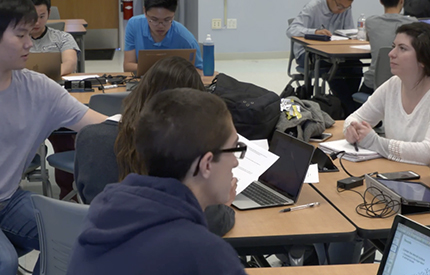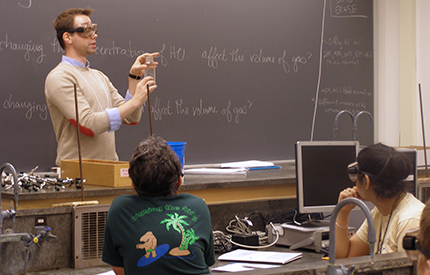Onsite or Online, Good Teaching is Good Teaching
May 21, 2020 | By Cynthia Dillon
Thomas Bussey calls his career focused on chemistry education a “happy accident.” But when you consider the historically good student, with a nurse for a mom, a long-time interest in biochemistry that led to a doctorate, and experience teaching high school science, it’s anything but happenstance.
Bussey is an assistant teaching professor in the Department of Chemistry and Biochemistry at UC San Diego. His topics of research explore students’ understandings of non-experiential, abstract and/or emergent scientific phenomena and practices. Current projects focus on students’ biochemical intuition as influenced by external representations and alignment of laboratory practice, curriculum and assessment of chemical concepts and the nature of science. His first book, “Biochemistry Education: From Theory to Practice,” was published last fall.
 Professor Thomas Bussey's students at work in the learning studio space. Photo courtesy of Thomas Bussey, Department of Chemistry and Biochemistry
Professor Thomas Bussey's students at work in the learning studio space. Photo courtesy of Thomas Bussey, Department of Chemistry and Biochemistry
With a deep knowledge of curriculum and instruction—plus his recent selection for the UC San Diego 2019-20 Distinguished Teaching Award for Academic Senate Members by the Committee on Senate Awards—Bussey was the natural choice for a Division of Physical Sciences Student Success Center presentation organized to help inform Sloan Scholars who are interested in pursuing careers in education. His presentation entitled, “Transition to Online Learning,” is a useful reference for educators as they navigate the teaching and learning landscape during the coronavirus pandemic.
“There is an element of teaching lost outside of the classroom environment that puts the onus on the student to figure out what’s important and how to use information,” said Bussey. “Moving from the classroom to an online space is not a 1:1 transfer. There are a lot of things unique to the remote learning environment to consider. Instructional strategies often remain the same, though the platform and technicalities are different.”
The chemistry and biochemistry professor explained that educators have gotten used to how they’ve done things, but now they have to create something new and meaningful in a virtual environment—an investment that requires a large amount of time and effort. This has been destabilizing for educators, many of whom are trying to translate their in-person teaching experience into the virtual classroom. “I wish I could give them a quick fix, but that just doesn’t exist.” Bussey said. His remedy is to offer a more philosophical approach—10 guidelines—that encourage educators to think creatively, flexibly and experimentally as they navigate the shifting educational environment:
- Good teaching is good teaching
- Students need clear expectations
- Communicate with students early and often
- Be prepared, but flexible
- Teaching is not telling, and learning is not listening
- Knowledge is individually constructed but socially negotiated
- Create multiple points of entry
- Consider access and equity
- Align assessments to learning objectives
- Allow students to demonstrate knowledge (not their ability to Google)
“Good teaching is good teaching,” said Bussey. “Teachers can re-conceptualize more tools and more options to pull out and use, and a variety of different strategies to determine how much things carry forward, and to find new tools that are more effective.”
When it comes to good teaching, Bussey explains that teachers and students typically communicate through interaction. The challenge is how to make things real in virtual classrooms. So, students need clear expectations from teachers, especially within the individuality that is unique to online students, who are more responsible for their own learning.
 Bussey conducting a lab workshop on campus. Photo courtesy of Thomas Bussey, Department of Chemistry and Biochemistry
Bussey conducting a lab workshop on campus. Photo courtesy of Thomas Bussey, Department of Chemistry and Biochemistry
“Online learning doesn’t mean students should be doing anything less than they would be doing in a traditional classroom,” said Bussey. “Expectations of students should align with what they would be in a traditional classroom.”
Communicating with students, according to Bussey, also includes making sure they know where to find information and materials across platforms. So giving feedback beyond grades—how to improve and process information independently—is important.
Preparation with flexibility is also important in the transition to remote teaching. “It is important to know what kind of learning environment you are trying to achieve, but you also need to be aware of when things are working,” Bussey said, adding to keep in mind the different ways people learn. “Learning and teaching is not a transmission model; telling is not teaching, and listening is not learning. If it were that simple, then a lecture online or in person would be equivalent and sufficient. Knowledge, however, is not an object to be passed from one person to the next. We are curating a way of thinking, guided and modeled by an educator, practiced and refined by the learner.”
He explained that “active learning”—versus by lecture only, which has higher failure rates—carries over from the traditional to the remote instruction classroom. “Students must process the information given to them in a way that allows them to engage more deeply with the material and think critically about what it is that they are doing and how,” said Bussey.
This goes hand-in-hand with another key guideline: knowledge is individually constructed but socially negotiated.
“The experiences that teachers give students in a remote environment create the basis for how students understand the material and their building of their own understanding of what teachers are trying to teach—it’s all influenced by students’ perceptions. Human knowledge is constructed from experience,” Bussey said.
Students also need different points of entry to access information. Different platforms—computers, tablets, etc.—and technology tools are useful in this regard. Access and equity are important considerations for educators, too.
“Measures of student learning become even more important in a remote instructional environment because there are no other metrics regarding participation,” noted Bussey. “Assessment should be based on learning objectives that teachers should articulate to students—define what’s important and determine how to assess it.”
Bussey said that a common concern among faculty regarding online learning is academic integrity. For example, if students are given an exam, how does the teacher know they won’t just Google the answers? Bussey argues that he would want students to take a question out into the world and find the resources to answer it correctly in a scientifically acceptable way.
“If a student Googles the answer and finds it, then it’s an acceptable way of answering a question,” he said. “In a remote environment teachers are free to allow students to demonstrate how they can show knowledge—beyond an exam—including seeking outside resources that gives them access to materials from the internet and from materials from each other. So collaborative online platforms can be used by teachers to allow students to work together to solve complex problems.”
Rather than demonstrating their Google skills, though, Bussey references Bloom’s Taxonomy—a hierarchical arrangement of cognitive skills to enhance teaching and learning—as a way of thinking about how students can demonstrate knowledge.
“We want students to do more complex, dynamic things to demonstrate a more robust understanding of material rather than answering a few multiple choice questions,” he said. “By changing the structure of assessments and allowing students to demonstrate understanding in more complex, dynamic ways, teachers can develop a more complete understanding of a student’s knowledge base.”
According to Bussey, the remote environment offers educators a unique opportunity to experiment—if things aren’t working, there is no precedent that says they can’t change what they’re doing and how they’re doing it.”
Here Bussey invokes Voltaire, “Perfect is the enemy of the good.”
“Teaching is a dynamic event. Learning is an iterative process,” said Bussey, “And it’s uniquely individualized to the student, the process, the space that we’re in.”
